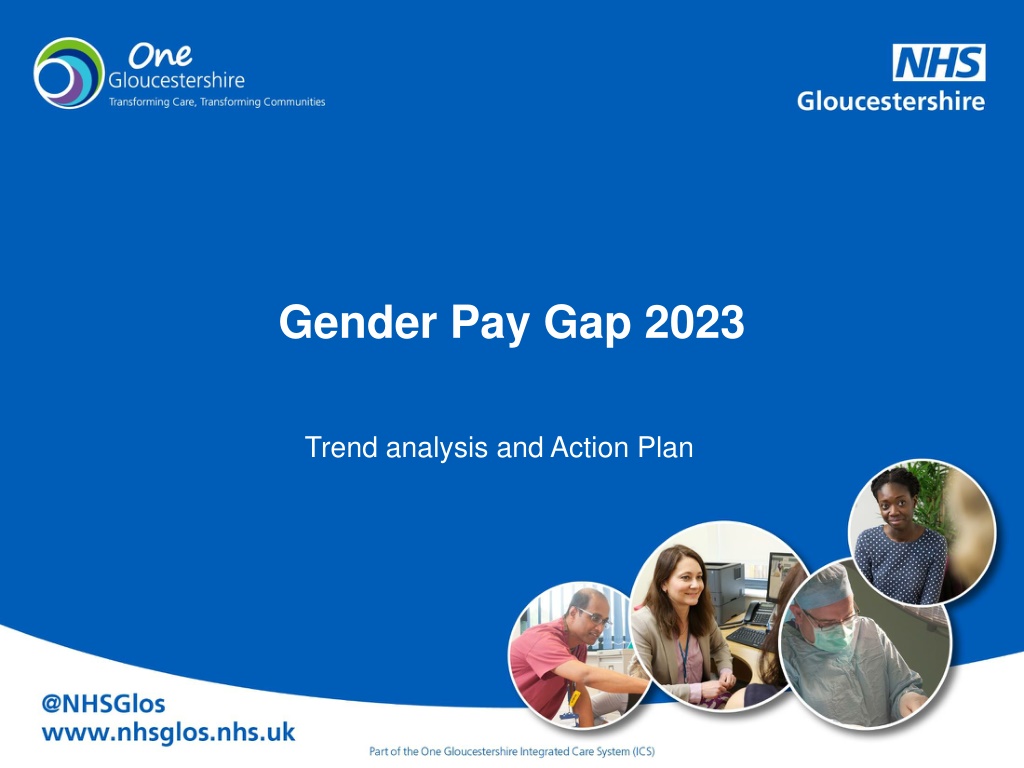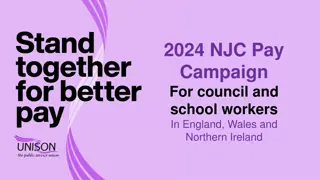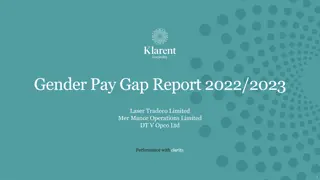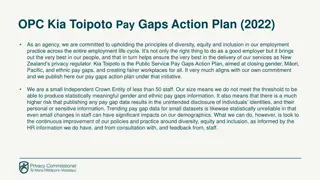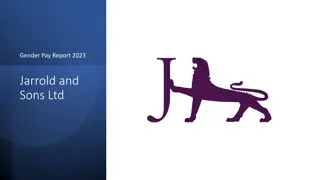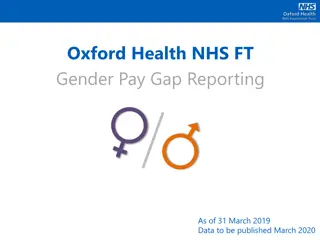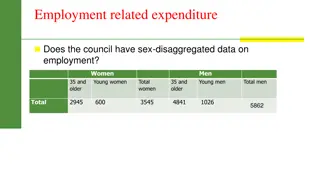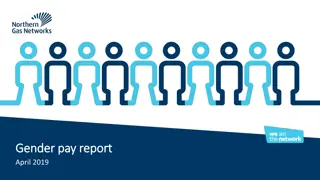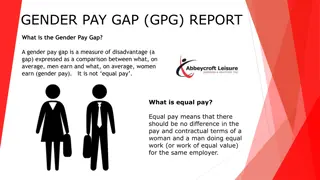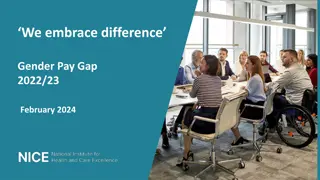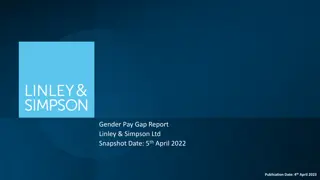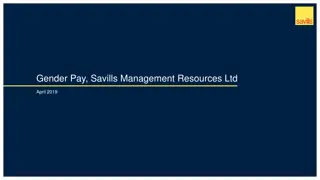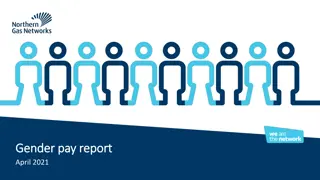Gender Pay Gap Analysis and Action Plan for 2023
The gender pay gap persists, with women earning significantly less than men due to various factors including caring responsibilities, low-skilled jobs, part-time work, and discrimination. In 2023, the national median pay gap stands at 9.4%. NHS Gloucestershire ICB has reported a mean gender pay gap of 17.91% as of March 31, 2023, showing a minor decrease from the previous year. The organization has a higher proportion of female employees in lower quartiles and more males in the upper quartile. Action plans to address this gap are crucial for achieving gender pay equality.
Download Presentation

Please find below an Image/Link to download the presentation.
The content on the website is provided AS IS for your information and personal use only. It may not be sold, licensed, or shared on other websites without obtaining consent from the author.If you encounter any issues during the download, it is possible that the publisher has removed the file from their server.
You are allowed to download the files provided on this website for personal or commercial use, subject to the condition that they are used lawfully. All files are the property of their respective owners.
The content on the website is provided AS IS for your information and personal use only. It may not be sold, licensed, or shared on other websites without obtaining consent from the author.
E N D
Presentation Transcript
Gender Pay Gap 2023 Trend analysis and Action Plan 0
What is the gender pay gap? The gender pay gap reflects inequalities and discrimination in the labour market that mostly affect women. Women earn significantly less than men over their entire careers for complex, often interrelated reasons. These include: differences in caring responsibilities: - child care often called the maternity gap and caring for elderly relatives more women in low skilled and low paid work more women in part-time work outright discrimination The national median pay gap remains stubbornly wide at 9.4% the same level as in 2017-18, when employers were first required to publish the information. The gap remains larger in the public sector at 15.1%. This compares with 8% in the private sector, and both are broadly similar to last year s figures (Reference The Guardian. Source: gov.uk gender pay gap service: data as of 5 April 2023) 1
NHS Gloucestershire ICB report on Gender Pay Gap In order to meet the requirements of The Equality Act 2010 (Gender Pay Gap Information) Regulations 2017, Gloucestershire Integrated Care Board (GICB) is required to calculate and publish the following information: 1. 2. 3. 4. 5. 6. 7. 8. The mean gender pay gap The median gender pay gap The mean bonus gender pay gap The median bonus gender pay gap The proportion of males receiving a bonus payment The proportion of females receiving a bonus payment The proportion of males and females in each quartile pay band A written statement, authorised by an appropriate senior person, which confirms the accuracy of the calculations. Calculations are based on pay related information, extracted from ESR, as of 31 March 2023 shows that Gloucestershire ICB employed a headcount staff of 453 staff equating to 386 WTEs, for all permanent and fixed term employees. NB: Bonus payments were not made to staff at GICB during the period 01.04.22 to 31.03.23 nor in any of the previous 5 years; there are no calculations for points 3 to 6 (above). 2
The Mean Gender Pay Gap The mean hourly rate for male full pay relevant employees was 30.49. The mean hourly rate for female full pay relevant employees was 25.02. The mean gender pay gap is 17.91% as at 31 March 2023. The trend between 2022 to 2023 is a minor decrease of 0.04% demonstrating the gap remains stubbornly high in comparison to men. However there has been an overall decrease from 23.76%, a high point in March 2020 by 5.85% to 17.91% in March 2023. 4
Gender pay differentials by pay band Quartile Pay Bands 31.03.23 1 Lower 2 3 4 - Upper Total Female Male Female % 82.14 76.79 75.70 61.48 73.8% Male % 92 86 81 75 334 20 26 26 47 119 17.86 23.21 24.30 38.52 26.2% Gloucestershire ICB employs a higher proportion of women than men in each quartile pay band. There is a significantly higher proportion of female employees than male in the lower two quartiles and proportionally more males in the upper quartile. The proportion of women employed in the lower two quartiles is higher than the organisational split, whilst the number of woman employed in the upper two quartiles is lower than the overall organisational split and significantly lower in the upper quartile. Based on the gender split across the wider organisation, women are overrepresented in the lower two quartiles and underrepresented in the upper quartile. This will be the main reason for our gender pay gap 5
Actions being taken to tackle the GPG The following policies and actions are in place to encourage women to continue their careers at the ICB through the various stages in their life and support them to career progress irrespective of maternity leave or carers leave: Flexible working policies supporting a variety of working patterns with over 86% of staff confirming that they obtained their flexible working option in the 2022 survey Make the most of flexible working (ensuring it is equally available at the upper quartile pay bands) regular briefings and training focusing on flexible working and ensuring staff have a work-life balance; Hybrid working allowing all staff to work at home and in the office with a one day a week in the office policy calculated as 20% of working time in the office during the month and pro-rata for part time workers to ensure that both full-time and part-time workers are treated equally; Training given to all staff and to managers on creating a culture of conscious inclusion focusing on discrimination and its effects and creating a culture where those with protected characteristics can thrive and be supported; Manage family-friendly leave successfully (e.g., pregnancy-related appointments, keeping in touch (KIT communications) and parental leave). Further training is being provided to directorates and team Supporting health and wellbeing schemes and initiatives including running a women s health day on 18th October 2023, Developing our policies encouraging women are supported within the workplace to thrive and progress including Flexible Working Policy; Other Leave Policy, Menopause Policy and resources etc Women s Health day and intranet pages including those on prolapse and other health conditions that affect women s health Wellbeing resources (EAP, Wellbeing Line, EAP etc) available to all staff to help support staff and keep them at work rather than retire or leave their jobs due to work pressures; Setting up a carers staff network and resources to support staff and predominantly women with caring responsibilities Setting up a Coaching Event on 25th April 2024 with potential to include session / workshop on career coaching with an ED&I focus TBC Further work needs to be undertaken on career coaching, talent management and support to encourage women into more senior roles within the ICB and NHS Gloucestershire. 6
